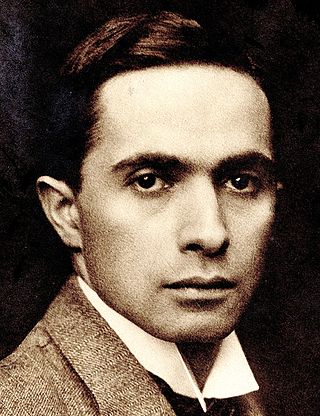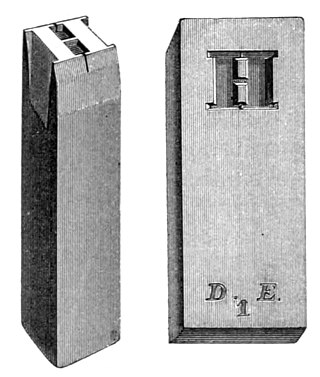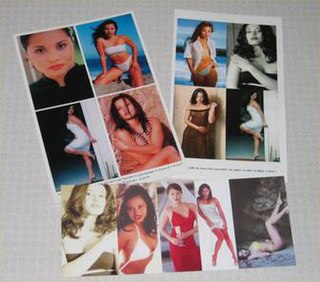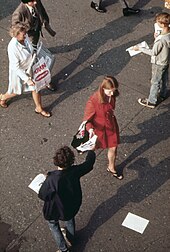
Ink is a gel, sol, or solution that contains at least one colorant, such as a dye or pigment, and is used to color a surface to produce an image, text, or design. Ink is used for drawing or writing with a pen, brush, reed pen, or quill. Thicker inks, in paste form, are used extensively in letterpress and lithographic printing.

The CMYK color model is a subtractive color model, based on the CMY color model, used in color printing, and is also used to describe the printing process itself. The abbreviation CMYK refers to the four ink plates used: cyan, magenta, yellow, and key (black).
Desktop publishing (DTP) is the creation of documents using page layout software on a personal ("desktop") computer. It was first used almost exclusively for print publications, but now it also assists in the creation of various forms of online content. Desktop publishing software can generate layouts and produce typographic-quality text and images comparable to traditional typography and printing. Desktop publishing is also the main reference for digital typography. This technology allows individuals, businesses, and other organizations to self-publish a wide variety of content, from menus to magazines to books, without the expense of commercial printing.

Retro style is imitative or consciously derivative of lifestyles, trends, or art forms from history, including in music, modes, fashions, or attitudes. In popular culture, the "nostalgia cycle" is typically for the two decades that begin 20–30 years ago.

Business cards are cards bearing business information about a company or individual. They are shared during formal introductions as a convenience and a memory aid. A business card typically includes the giver's name, company or business affiliation and contact information such as street addresses, telephone number(s), fax number, e-mail addresses and website. Before the advent of electronic communication, business cards also included telex details. Now they may include social media addresses such as Facebook, LinkedIn and Twitter. Traditionally, many cards were simple black text on white stock, and the distinctive look and feel of cards printed from an engraved plate was a desirable sign of professionalism. In the late 20th century, technological advances drove changes in style, and today a professional business card will often include one or more aspects of striking visual design.

O scale is a scale commonly used for toy trains and rail transport modelling. Introduced by German toy manufacturer Märklin around 1900, by the 1930s three-rail alternating current O gauge was the most common model railroad scale in the United States and remained so until the early 1960s. In Europe, its popularity declined before World War II due to the introduction of smaller scales.

The A. C. Gilbert Company was an American toy company, once one of the largest in the world. Gilbert originated the Erector Set, which is a construction toy similar to Meccano in the rest of the world, and made chemistry sets, microscope kits, and a line of inexpensive reflector telescopes. In 1938, Gilbert purchased the American Flyer, a manufacturer of toy trains. The Gilbert Company struggled after the death of its founder in 1961 and went out of business in 1967. Its trademarks and toy lines were sold to other companies.
A newsletter is a printed or electronic report containing news concerning the activities of a business or an organization that is sent to its members, customers, employees or other subscribers. Newsletters generally contain one main topic of interest to its recipients. A newsletter may be considered grey literature. E-newsletters are delivered electronically via e-mail and can be viewed as spamming if e-mail marketing is sent unsolicited.

Digital printing is a method of printing from a digital-based image directly to a variety of media. It usually refers to professional printing where small-run jobs from desktop publishing and other digital sources are printed using large-format and/or high-volume laser or inkjet printers.

Direct marketing is a form of communicating an offer, where organizations communicate directly to a pre-selected customer and supply a method for a direct response. Among practitioners, it is also known as direct response marketing. In contrast to direct marketing, advertising is more of a mass-message nature.

Infoshops are places in which people can access anarchist or autonomist ideas. They are often stand-alone projects, or can form part of a larger radical bookshop, archive, self-managed social centre or community centre. Typically, infoshops offer flyers, posters, zines, pamphlets and books for sale or donation. Other items such as badges, locally produced artworks and T-shirts are also often available. Infoshops can also provide printing and copying facilities for people to produce their own literature or have a meeting space.

A brochure is a promotional document primarily used to introduce a company, organization, products, or services and inform prospective customers or members of the public of the benefits. Although, initially, a paper document that can be folded into a template, pamphlet, or leaflet, a brochure can also be a set of related unfolded papers put into a pocket folder or packet or can be in digital format.

Joseph Christian Leyendecker was one of the most prominent and financially successful freelance commercial artists in the U.S. He was active between 1895 and 1951 producing drawings and paintings for hundreds of posters, books, advertisements, and magazine covers and stories. He is best known for his 80 covers for Collier's Weekly, 322 covers for The Saturday Evening Post, and advertising illustrations for B. Kuppenheimer men's clothing and Arrow brand shirts and detachable collars. He was one of the few known gay artists working in the early-twentieth century U.S.

Punchcutting is a craft used in traditional typography to cut letter punches in steel as the first stage of making metal type. Steel punches in the shape of the letter would be used to stamp matrices into copper, which were locked into a mould shape to cast type. Cutting punches and casting type was the first step of traditional typesetting. The cutting of letter punches was a highly skilled craft requiring much patience and practice. Often the designer of the type would not be personally involved in the cutting.

A comp card is a marketing tool for actors and especially models. They serve as the latest and best of a model's portfolio and are used as a business card. A Z-CARD is also a folded leaflet format, typically used for marketing communications campaigns for example a loyalty programme or seasonal promotion.
Woodrow Phoenix is a British comics artist, writer, editorial illustrator, graphic designer, font designer and author of children's books.

In the picture framing industry, a mat is a thin, flat piece of paper-based material included within a picture frame, which serves as additional decoration and to perform several other, more practical functions, such as separating the art from the glass. Putting mats in a frame is called matting, a term which can also usually be used interchangeably with mat. The French term, occasionally used in English, is passe-partout. A picture is placed beneath it, with the cutout framing it. The passe-partout serves two purposes: first, to prevent the image from touching the glass, and second, to frame the image and enhance its visual appeal. The cutout in the passe-partout is usually beveled to avoid casting shadows on the picture. The French word may also be used for the tape used to stick the back of the picture to its frame.
Book folding is the stage of the book production process in which the pages of the book are folded after printing and before binding.
The Blockhouse of Boston was a pioneering art and design cooperative of alumni from the Massachusetts College of Art in Boston, Massachusetts that opened its doors in 1947. Blockhouse artisans, primarily the then-recent art school graduate Janet Doub Erickson, designed and produced original textiles including draperies, wall hangings, table linens, costume treatments and other art. The co-op specialized in linoleum blockprints — also known as linocuts — and screen printing. Blockhouse was known for original use of New England themes and motifs intermingled with bold ethnic designs at times inspired by pre-Columbian art and sometimes with modernist motifs. As a journalist described some of Blockhouse principal designer Janet Doub Erickson's inspirations in a 1952 profile, "she goes to New Guinea for her motif, 'Checkerboard,' to China for her "Quan-Yin" design, to Guatemala for "Mayan Stele," and to a Northwest Indian reservation for "Totemotif."

Marvel Tales and Unusual Stories were two related American semi-professional science fiction magazines published in 1934 and 1935 by William L. Crawford. Crawford was a science fiction fan who believed that the pulp magazines of the time were too limited in what they would publish. In 1933, he distributed a flyer announcing Unusual Stories, and declaring that no taboos would prevent him from publishing worthwhile fiction. The flyer included a page from P. Schuyler Miller's "The Titan", which Miller had been unable to sell to the professional magazines because of its sexual content. A partial issue of Unusual Stories was distributed in early 1934, but Crawford then launched a new title, Marvel Tales, in May 1934. A total of five issues of Marvel Tales and three of Unusual Stories appeared over the next two years.




















